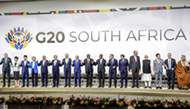Many Americans know that there are economic policy differences between Democrats and Republicans . But few are aware of two important facts about the post-World War II era, both of which are brilliantly delineated in a new book, “Unequal Democracy,” by Larry M. Bartels, a professor of political science at Princeton University in New Jersey. Understanding them might help voters see what could be at stake, economically speaking, in November.
I call the first fact the Great Partisan Growth Divide. Simply put, the United States economy has grown faster, on average, under Democratic presidents than under Republicans.
The stark contrast between the booming Clinton years and the dreary Bush years is familiar because it is so recent. But while it is extreme, it is not atypical. Data for the whole period from 1948 to 2007, during which Republicans occupied the White House for 34 years and Democrats for 26, show average annual growth of real gross national product of 1.64 percent per capita under Republican presidents versus 2.78 percent under Democrats.
Such a large historical gap in economic performance between the two parties is rather surprising, because presidents have limited leverage over the nation’s economy. Most economists will tell you that Federal Reserve policy and oil prices, to name just two influences, are far more powerful than fiscal policy. But statistical regularities, like facts, are stubborn things. You bet against them at your peril.
The second big historical fact, which might be called the Great Partisan Inequality Divide, is the focus of Professor Bartels’s work.
It is well known that income inequality in the United States has been on the rise for about 30 years now . But Professor Bartels unearths a stunning statistical regularity: Over the entire 60-year period, income inequality trended substantially upward under Republican presidents but slightly downward under Democrats, thus accounting for the widening income gaps over all. And the bad news for America’s poor is that Republicans have won five of the seven elections since 1980.
The Great Partisan Inequality Divide is not limited to the poor.
To get a more detailed look, Professor Bartels studied the postwar history of income gains at five different places in the income distribution.
When Democrats were in the White House, lower-income families experienced slightly faster income growth than higher-income families - which means that incomes were equalizing. In stark contrast, there was much faster income growth for the affluent when Republicans were in the White House - thus widening the gap in income.
The sources of such large differences make for a slightly complicated story. In the early part of the period - say, the pre-Reagan years - the Great Partisan Growth Divide accounted for most of the Great Partisan Inequality divide, because the poor do relatively better in a high-growth economy.
Beginning with the Reagan presidency, however, growth differences are smaller and tax and transfer policies have played a larger role.
We know, for example, that Republicans have typically favored large tax cuts for upper-income groups while Democrats have opposed them. In addition, Democrats have been more willing to raise the minimum wage, and Republicans have been more hostile toward unions.
The two Great Partisan Divides combine to suggest that, if history is a guide, an Obama victory in November would lead to faster economic growth with less inequality, while a McCain victory would lead to slower economic growth with more inequality.
스마터리빙
more [ 건강]
[ 건강]이제 혈관 건강도 챙기자!
[현대해운]우리 눈에 보이지 않기 때문에 혈관 건강을 챙기는 것은 결코 쉽지 않은데요. 여러분은 혈관 건강을 유지하기 위해 어떤 노력을 하시나요?
 [ 건강]
[ 건강]내 몸이 건강해지는 과일궁합
 [ 라이프]
[ 라이프]벌레야 물럿거라! 천연 해충제 만들기
 [ 건강]
[ 건강]혈압 낮추는데 좋은 식품
[현대해운]혈관 건강은 주로 노화가 진행되면서 지켜야 할 문제라고 인식되어 왔습니다. 최근 생활 패턴과 식생활의 변화로 혈관의 노화 진행이 빨라지고
사람·사람들
more
김응화 단장, 아쿠아리움 퍼시픽 ‘헤리티지 어워드’
김응화무용단의 김응화 단장이 롱비치의 아쿠아리움 오브 더 퍼시픽이 수여하는 2025년 ‘헤리티지 어워드’의 영예를 안았다. 올해 처음 개최된 …

이정임 무용원, 팬아시아 전통예술 경연대회
남가주 최대 규모의 아시아 전통 예술 경연대회인 팬아시아 댄스 앤 드럼 대회에서 이정임무용원의 청소년 단원들이 경연에 참가해서 전체 대상 등 …
유희자 국악무용연구소, 팬아시아 전통예술대회
지난 15일 샌개브리얼 셰라톤 호텔에서 열린 남가주 최대 규모의 전통 무용대회인 팬아시아 댄스 앤 드럼 대회에서 유희자 국악무용연구소(원장 유…
송년행사 안내해드립니다
다사다난했던 2025년이 이제 종착점을 향해 달려가고 있습니다. 한 해를 잘 마무리하고 2026년 새해를 힘차게 맞기 위한 다짐을 하는 송년 …
‘군중’ 시리즈 이상원 작가 첫 LA전시회
아케디아 소재 홈갤러리인 ‘알트프로젝트’(대표 김진형)가 오는 29일(토)부터 한국 블루칩 작가 이상원이 참여하는 전시 ‘인 드리프트(In D…
많이 본 기사
- ‘쿠데타 모의’ 브라질 前대통령 징역형 집행 하루 전 체포
- 딥페이크 사기에 가장 많이 악용된 스타는 테일러 스위프트
- 시카고서 10대 집단난동 중 총격…트… 1
- 사과·尹절연 포함될까…국힘, ‘비상계엄 1년’ 메시지 수위 고심
- SF 갓스 이미지 단원 50여명
- ‘당정대 삼각편대’ 정청래·김민석·강훈식…주목되는 광폭 행보
- 임시정부가 펴낸 ‘한일관계사료집’ 복원 거쳐 공개된다
- AI탑재 곰인형이 성관계·약물 대화까지?…美 소비자단체 경고
- [특파원 시선] 트럼프도 떨게만든 물가…정책 유턴 신호탄될까
- 실타래 소재로 한 섬유 회화 선보여
- 한덕수 재판서 드러난 ‘계엄의 밤’…내란 첫 법적판단 나온다
- 삼성 사장단 파격 인사 ‘기술인재’ 박홍근 발탁
- 美 주도 종전안에 유럽 정상들 “재논의 필요”…신중·의구심
- 조영구, 주식으로 21억 잃었는데 ‘10억’ 집값도 하락 “미용실서 아줌마 말 듣고 분양”
- 이지혜, 인중축소술 후 “남편이 하향세 탈거라 저주”→ “존재 자체로 우린 특별해” 멘탈 잡는 중
- 트럼프, 측근이었다 등돌린 의원 사임 발표에 “지지율 급락 탓”
- “살 못 뺐는데”..이장우♥조혜원, 결혼 이틀 앞두고 웨딩 사진 공개
- 자고나면 부푼다… 증시 저승사자, AI 버블론
- ‘헌법존중 TF’ 본격 가동 “내란 행위 제보받는다”
- [오피셜] 손흥민-메시, 약 8만 관중 앞 맞대결 확정... 내년 MLS 개막전 격돌
- ‘김건희 계좌 관리인’ 도이치 주가조… 1
- ‘부친 빚투 논란’ 김혜성 “순간 감정 추스르지 못해, 깊이 반성한다” 사과문 공개
- 푸틴 특사 “트럼프 평화 계획은 우크라 구하기 위한 것”
- ‘케데헌’, 오스카 애니메이션상 후보자격 갖춘 35편에 포함
- 역사적인 누리호 4차 발사 ‘카운트다운’…관람 명당 각광
- ‘단 1승이면 전설이 된다’ 안세영, 호주오픈 결승 진출... 女 배드민턴 단식 최다승 경신 도전
- 미국 기침에 주저앉는 코스피… ‘오천피 신기루’
- 美 빠진 유엔기후총회 ‘화석연료’ 언급 빠진 선언문 내고 종료
- 뉴욕증시 거품 우려에 격동의 한 주… “월가, 더 큰 혼란 대비”
- 트럼프 2,000달러 관세 배당 없던일로?
- “美, 23일 제네바서 우크라와 종전안 논의…루비오 등 참석”
- “로봇이 사람 두개골 깰 수 있어”…피겨AI, 前직원에 피소
- 동생 공개 후 ‘군인’ 차은우 ‘최신 근황’.. “쌍둥이 형제?” 귀까지 똑같이 ‘잘생김 DNA’
- ‘세계 최강’ 최민정, 월드투어 전종목 1위 예선 통과... 金 싹쓸이 정조준
- 李대통령, G20 정상회의 둘째날… ‘AI시대’ 국제협력 구상 밝힌다
- 오늘 남아공 G20 정상회의 개막
- ‘채상병 수사외압’ 윤석열 등 12명 재판에
- 공직사회 뒤숭숭… “성과 내려면 희생 불가피”
- 뉴욕증시, 연준·트럼프 ‘양대 풋’에 반색…동반 강세 마감
- 성시경, 매니저 배신에 끝내 눈물.. “너무 힘들지만 마음 다잡아”
- “트럼프 정부, 대법 패소 대비 대체 관세 수단 준비”
- ‘배신자’ 찍힌 옛측근 그린 “의원직… 1
- 평양 무인기 보낸 드론사… “암호화 강화” 사이버사 조언 묵살
- 이민법원 적체에… 한인들‘신분 위기’
- CDC ‘백신은 자폐증 유발 안한다’ 입장 변경…보건장관 지시
- G20 정상회의 첫날부터 ‘남아공 정상선언’ 전격 채택
- “맘다니도 트럼프도 승자”…화기애애 백악관 회동 예상밖 케미
- “함께 만들어 가는 평화의 약속”
- ‘김민재 위기! 안 그래도 제 3센터백인데’ 강력 경쟁자 日 이토, 복귀 임박했다... “몇 달간 중요한 기둥될 것”
- LA항 대형 컨테이너선 화재…일부 터미널 운영 중단
1/5지식톡

-
 테슬라 자동차 시트커버 장착
0
테슬라 자동차 시트커버 장착
0테슬라 시트커버, 사놓고 아직 못 씌우셨죠?장착이 생각보다 쉽지 않습니다.20년 경력 전문가에게 맡기세요 — 깔끔하고 딱 맞게 장착해드립니다!장착비용:앞좌석: $40뒷좌석: $60앞·뒷좌석 …
-
 식당용 부탄가스
0
식당용 부탄가스
0식당용 부탄가스 홀세일 합니다 로스앤젤레스 다운타운 픽업 가능 안녕 하세요?강아지 & 고양이 모든 애완동물 / 반려동물 식품 & 모든 애완동물/반려동물 관련 제품들 전문적으로 홀세일/취급하는 회사 입니다 100% …
-
 ACSL 국제 컴퓨터 과학 대회, …
0
ACSL 국제 컴퓨터 과학 대회, …
0웹사이트 : www.eduspot.co.kr 카카오톡 상담하기 : https://pf.kakao.com/_BEQWxb블로그 : https://blog.naver.com/eduspotmain안녕하세요, 에듀스팟입니다…
-
 바디프렌드 안마의자 창고 리퍼브 세…
0
바디프렌드 안마의자 창고 리퍼브 세…
0거의 새제품급 리퍼브 안마의자 대방출 한다고 합니다!8월 23일(토)…24일(일) 단 이틀!특가 판매가Famille: $500 ~ $1,000Falcon: $1,500 ~ $2,500픽업 & 배송직접 픽업 가능LA…
-
 바디프렌드 안마의자 창고 리퍼브 세…
0
바디프렌드 안마의자 창고 리퍼브 세…
0거의 새제품급 리퍼브 안마의자 대방출 한다고 합니다!8월 23일(토)…24일(일) 단 이틀!특가 판매가Famille: $500 ~ $1,000Falcon: $1,500 ~ $2,500픽업 & 배송직접 픽업 가능LA…
케이타운 1번가
오피니언
 조지 F·윌 워싱턴포스트 칼럼니스트
조지 F·윌 워싱턴포스트 칼럼니스트 [조지 F. 윌 칼럼] 세계를 가장 크게 바꾼 사건, 미국 혁명전쟁
 이희숙 시인·수필가
이희숙 시인·수필가 [금요단상] 낙엽 위에 남겨진 향
 김정곤 / 서울경제 논설위원
김정곤 / 서울경제 논설위원[만화경] ‘중동판 꽌시’ 와스타

[왈가 왈부] ‘패트 충돌’ 선고에 여야 “정치 판결” “자성 촉구” 아전인수?
 수잔 최 한미가정상담소 이사장 가정법 전문 변호사
수잔 최 한미가정상담소 이사장 가정법 전문 변호사 [수잔 최 변호사의 LIFE &] 서울 가을 자락에서 만난 쉼터
 강민수 을지대 첨단학부 교수 한국인공지능학회장
강민수 을지대 첨단학부 교수 한국인공지능학회장 [기고] 디지털 주권의 토대, 소버린 클라우드
1/3지사별 뉴스

론 김 뉴욕주하원의원, 플러싱 YMCA에 건축지원금 300만불 전달
론 김 뉴욕주하원의원이‘플러싱 커먼스’(Flushing Commons)에 새롭게 들어설 예정인 플러싱 YMCA에‘건축지원금’(Capital F…
이민법원 적체에… 한인들‘신분 위기’

“함께 만들어 가는 평화의 약속”
“오늘 출범식은 단순한 시작이 아니라 한인사회와 함께 만들어가는 평화와 희망의 약속입니다. 한반도의 평화는 거대한 정치적 언어가 아닌 우리 같…
VA 34%·MD 30%만 모기지 ‘0’

UC 등록금 치솟는다 “매년 최고 5% 인상”
UC 이사회가 매년 최대 5%까지 신입생들의 등록금을 인상할 수 있는 ‘등록금 안정화 프로그램’을 통과시켜 향후 UC 학생들과 학부모들의 학비…
[알립니다]‘온정의 슬리핑백’ 보내기 운동

오늘 하루 이 창 열지 않음 닫기 



















































.png)


댓글 안에 당신의 성숙함도 담아 주세요.
'오늘의 한마디'는 기사에 대하여 자신의 생각을 말하고 남의 생각을 들으며 서로 다양한 의견을 나누는 공간입니다. 그러나 간혹 불건전한 내용을 올리시는 분들이 계셔서 건전한 인터넷문화 정착을 위해 아래와 같은 운영원칙을 적용합니다.
자체 모니터링을 통해 아래에 해당하는 내용이 포함된 댓글이 발견되면 예고없이 삭제 조치를 하겠습니다.
불건전한 댓글을 올리거나, 이름에 비속어 및 상대방의 불쾌감을 주는 단어를 사용, 유명인 또는 특정 일반인을 사칭하는 경우 이용에 대한 차단 제재를 받을 수 있습니다. 차단될 경우, 일주일간 댓글을 달수 없게 됩니다.
명예훼손, 개인정보 유출, 욕설 등 법률에 위반되는 댓글은 관계 법령에 의거 민형사상 처벌을 받을 수 있으니 이용에 주의를 부탁드립니다.
Close
x